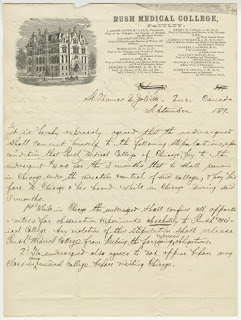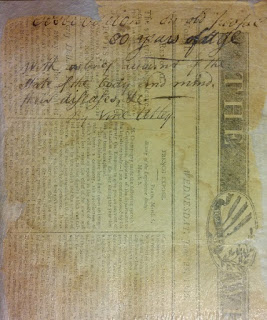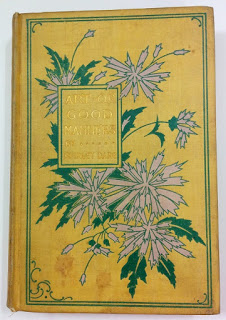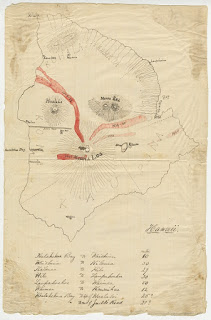Last week we ran the first half of our Clements Library summer reading list, pairing staff’s recently read and recommended books with items from the Clements’s collections. We continue now with other good reads and interesting connections to the Library’s rich historical sources.
Terese Austin, Curatorial Assistant and Reading Room Supervisor, recently read Rebecca Skloot’s The Immortal Life of Henrietta Lacks (New York: Crown Publishers, 2010). Skloot’s book recounts the story of how in 1951 doctors at Johns Hopkins Hospital removed and cultured cells from Henrietta Lacks, an African American woman who was suffering from cervical cancer, without her or her family’s permission. The cells were hugely influential for medical research and treatment, but the history of their use highlights serious questions about medical ethics. The Clements Library’s Alexis St. Martin Collection speaks to medicine’s long history of negotiating, and sometimes abusing, patient rights. In 1822 Alexis St. Martin, a French-Canadian employed by the American Fur Company at Mackinac, was shot in the stomach, leaving him with an open wound that exposed his digestive system for the rest of his life. St. Martin’s doctor, William Beaumont, offered medical care but also undertook a long series of experiments that revolutionized medical understanding of gastric processes. St. Martin eventually signed a contract with Beaumont, but the case highlights the thin line between medical consent and coercion.
 |
| In 1879, Alexis St. Martin was in conversation with Chicago medical facilities about taking up residency there for observation. He eventually refused due to failing health. |
Jayne Ptolemy, Curatorial Assistant and Reading Room Supervisor, has also been reading about the medical field in Atul Gawande’s Being Mortal: Medicine and What Matters in the End (New York: Metropolitan Books, 2014). This moving exploration of how modern medicine has affected the experience of aging and dying resonates across the centuries. The very human encounter with health and mortality can also be glimpsed in the Clements’s collection, Vine Utley, Observations on Old People 80 Years of Age, from the Duane Norman Diedrich Collection. Utley’s interviews with elderly residents of New London County, Connecticut, in the early nineteenth century provide remarkable details of an aging population’s health, family, and habits.
 |
| Utley’s Observations are written in a hand-made notebook with an 1806 newspaper cover. |
From the aged to the young, the Clements Library’s collections give insight into all stages of life. Oksana Linda, Rare Book Cataloger, enjoyed The Children’s Book (London: Chatto & Windus, 2009) by her favorite British author, A. S. Byatt. The novel describes the various adventures and complicated familial relations between a group of adults and children in the period from 1895 through the First World War. With a focus on children’s lives, and with one of the protagonists being a children’s book author, there is a clear connection to the Clements’s rich collection of juvenile books. Take, for example, Shirley Dare Power’s, Art of Good Manners, or, Children’s Etiquette. Dare advises children on proper behavior. “Girls like strong words,” she proclaims, “just as they like pickles, and cinnamon, and citron, and all sorts of unwholesome things—tastes that you will drop as soon as you begin to half know anything.”
 |
| The cover of S. D. Power’s Art of Good Manners (Akron: Werner Co., 1899) is nearly as colorful as the advice she gives within it. |
While Oksana’s pick centered in Europe, Janet Bloom, our Research Services Specialist, spent some time thinking about the sunny shores of Hawaii. She just finished Laura Fish Judd’s Honolulu: Sketches of Life in the Hawaiian Islands from 1828-1868 (Chicago: Lakeside Press, R. R. Donnelley, 1966). Laura Fish Judd, one of the earliest missionaries to the Hawaiian islands, served with the American Board of Commissioners for Foreign Missions, and this narrative of her experiences was first published in 1880. Complementing Judd’s vivid descriptions of Hawaii, are the Clements’s Horace Mann, Jr. Papers. Mann travelled to Hawaii in 1864 where he performed botanical research, which is documented in our collection. The Clements also has a series of Mann’s photographs and maps that gives a broader sense of Hawaii during both Laura Fish Judd and Horace Mann, Jr.’s stays on the islands.
 |
| This manuscript map of Hawaii, produced by Mann in 1864, shows the Mauna Loa lava flows from various years. |
The Clements staff’s reading choices span centuries and cover a wide range of topics. Clayton Lewis, Graphics Curator, finished a novel that does the same within one volume. He showed his mettle and read the innovative, if sprawling, Thomas Pynchon novel, Against the Day (New York: Penguin Press, 2006). Beginning aboard a hydrogen skyship on its way to the 1893 World’s Columbian Exposition, the tale spins its way across time and space, touching upon such topics as Colorado mining, labor unrest, gilded age New York, Nicholas Tesla, among others. The Clements does not seem to have any materials related to time travel, a problem that Clayton suggests, “In the future, we’ll have to do something about correcting in the past.” However, we do have a nice collection of materials related to the 1893 World’s Columbian Exposition in our Handy Family Papers, including a scrapbook of admission tickets compiled by Moses P. Handy, Chief of the Department of Publicity and Promotion for the momentous affair.
 |
| A sampling of some of the World’s Columbian Exposition admission tickets to be found in the Handy Family Papers. |
While the Clements has no evidence of time machines, the Library’s incredible collections may just be the next best thing. When you read our books, study our graphics and maps, and explore our manuscripts, you get a vivid sense of the past that transports your imagination, if not your body, back in time.
